Cruising with a large dog is somewhat less common. And while I’ve written quite a bit about cruising with a dog here on The Boat Galley (see all the dog posts), I don’t have much experience with a big dog on board. Our former cruising companion, Paz, weighed just 7 pounds.
I have gotten a fair number of questions about making crushing with a large dog work. So I worked with today’s guest post author, Pamela Douglas, to offer Cruising With Your Dog, an online course. The most extensive resource online, the course covers topics from adopting the perfect dog, training, making the boat work, health care underway, and checking into international destinations.
So keep reading for Pamela’s best tips for cruising with a large dog. And check out the Cruising With Your Dog course if your cruising plans include a furry family member or two.
6 Things To Make Cruising With A Large Dog Easy
When I see a dog on a cruising boat, I say, “Awwww.” When my dog appeared in the cockpit, people said, “Gee, you have a big dog on board.”
Compared to most golden retrievers, Honey was pretty small—only 50 pounds. But considering we sailed a Pacific Seacraft 34, she’s a lotta dog.
I didn’t regret having Honey on board even a little bit. But we had to make an effort to ensure cruising with a large dog was as easy as cruising with a small dog.
Well, almost as easy.

Here’s my list of what you’ll need to successfully cruise with a large dog. And no, none of them is a bigger boat.
Big Dog Fur Survival Plan
Many small dogs you meet on board are terriers or other non-shedding breeds.
Most popular large breeds, excepting poodles, shed like crazy. And dog hair gets everywhere. I swear I once saw a golden hair come up on the dipstick when checking our engine oil.
You must have a dog hair management plan or it will be a toss-up whether you’ll lose your boat first or your mind.
Most crucially, groom your dog to remove loose fur. Do not, as I once did, groom your dog in your aft cockpit while motoring. The station wagon effect will simply push the dog fur into your cabin.
Instead, wait until you go ashore. Take good de-shedding tools—I like my Furminator (see it here on Amazon) to take off bulk and a slicker brush to detangle. Collect as much fur as you can in a bag but if some gets away from you, local birds will find it a soft addition to their nests.
Pay attention to wind direction. I remember chatting with a couple on the dock in their beautiful, new Ranger Tug and realizing with horror that every time I pet Honey, a pile of fluff blew into their pristine boat.
We also check our scuppers frequently for hair and clean them out.
Finally, find the best mix of battery life and power in a small-size vacuum. (Note from Carolyn: We really like our Dyson cordless handheld. While it was expensive, it has much more “suck” than the other vacuums we’ve tried over the years and holds a charge well. Read more here. Friends with a shedding dog swear by their “pet hair” model.)
Big Dog No-Skid Solution
Of course it’s important that small dogs don’t slip and slide on deck as well as big dogs. But a big dog who injures himself or falls overboard requires a lot more muscle to deal with than a tiny dog.
And even tethering a dog so they stay attached to the boat if they go overboard is inferior to keeping them on deck to begin with.
Here’s what all boaters with dogs need to understand: no-skid is designed for shoes not to slip, not for paws. But your dog will be less likely to slip if you ensure their pads make full contact with the boat deck.
Look at the bottom of your dog’s paw. Does he have fur growing between the pads? If so, you need to clip it short. The fur creates a slipping hazard.
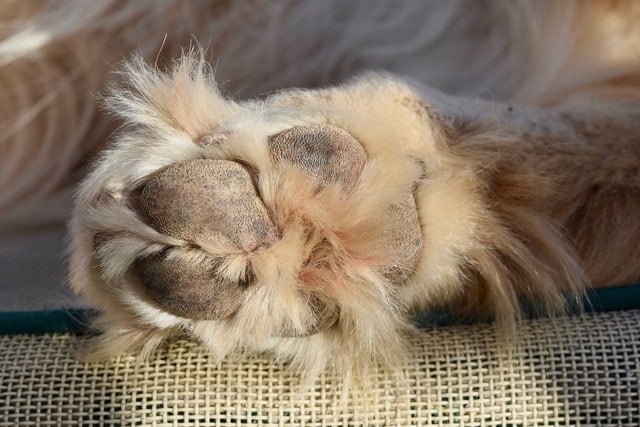
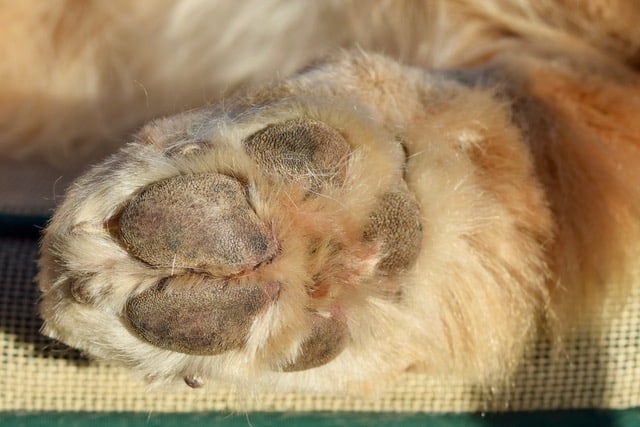
Long nails can also keep your dog from making contact with the deck. Trim or file those nails. If you hear clicking when your dog walks on a hard surface, her nails may be too long and keeping her pads from making contact.
If you’ve tried grooming and your dog is still slipping, some cruisers have found success with boots. A veterinarian has also developed toe grips, rubber rings that attach to the nail to help senior dogs get more traction for rising. They can also be useful for dogs on board.
Big Dog Food Management
We had nowhere on the boat to store a thirty-pound bag of dog food. On our small boat, I packaged about a week’s worth of food in a gallon freezer bag. Each bag had the date and description of the food written on the label.
We then stored it under our starboard settee, bringing out one package to store in the galley. It is much easier to store the food in small bags. And zipper freezer bags are airtight, helping the food to last longer.
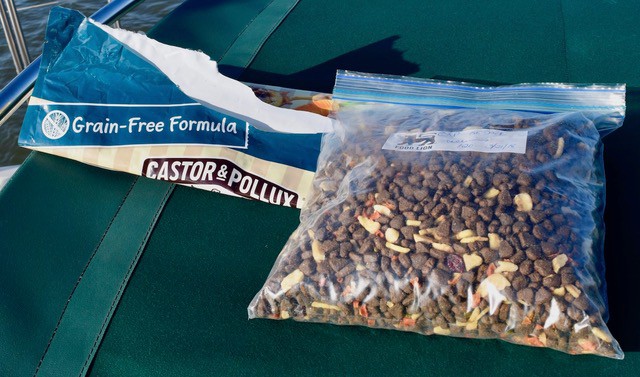
Although I had to break the food into smaller packages, I always saved the original bag. Or save a photo of all the identifying information on the bag on your phone..
Unfortunately, dog food may be recalled for contamination or containing dangerous ingredients. The information on the bag can help a vet save your pet’s life.
Moving A Big Dog
When your dog is young and boisterous (and you are too), you may think you don’t need to figure out how to move him. After all. they jump into the dinghy or scramble up companionway steps with ease.
But what if your dog gets injured or becomes less agile as they age? And what if you hurt yourself and can’t give them a helping hand? You need a plan that every member of the crew can use to get your big dog on, off, and around the boat as needed.
In the Boatyard
We were glad for our plan on the day Honey and I were in the cabin while our boat was on the hard. The boatyard give us 30 minutes notice that they were ready to splash our boat. My husband was working offsite. So it was up to me to get Honey off the boat before the travel lift arrived.
Luckily, with the help of Honey’s mountaineering harness and our block and tackle attached to the boom, I was able to lower Honey ten feet safely to the ground. (See it here on Amazon.)There is no way I could have slung a 50 pound golden retriever over my shoulder and climbed down a ladder. Glad we had a plan.
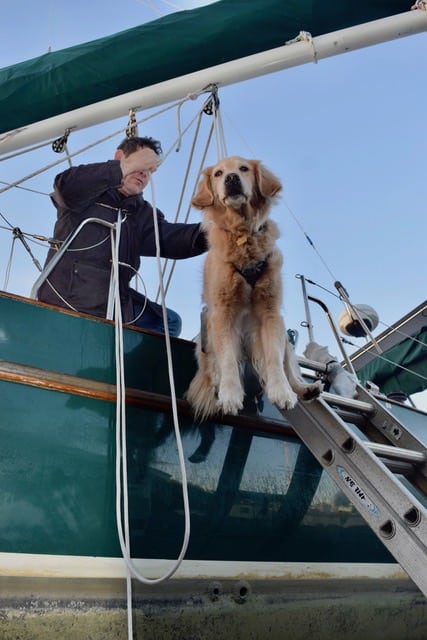
At Anchor
We used the same method to help Honey into the dinghy when we anchored. She found the tight-fitting harness much more secure than when we tried handing her off from the side aisle of the boat to someone standing in a bouncing dinghy.
At the Marina
When staying in a marina with fixed docks or even when the wind is blowing the boat off floating docks, we used a ramp to help Honey walk comfortably on and off the boat.
Because Honey is light, we lifted her into the cockpit. I trained her to jump up on the settee, making it easier for me to lift her. I placed her on the top step of our companionway ladder and tell her “in the cockpit” to get her to jump over the bridge deck.
To get her back into the cabin, Honey jumped over the bridge deck on cue so her front feet sit on the top step of the ladder. I then carried her back to the settee.
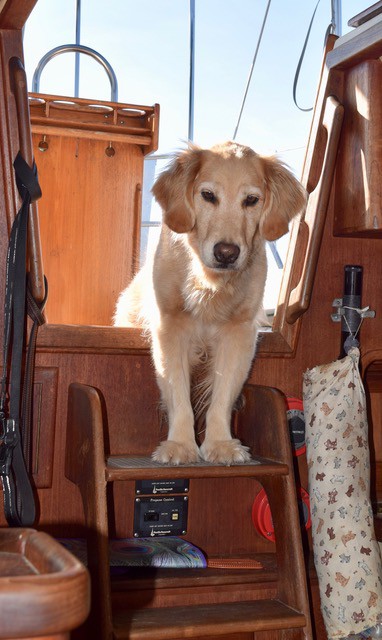
If she had been much bigger, we’d have had to work harder to find alternatives to get her up and down the steep ladder. Other cruisers with big dogs have recommended adding a back to the companionway ladder so a dog feels more secure scrambling up and down.
I also saw one clever cruiser’s picture of extensions he added to the companionway treads to make the angle less steep for their dog to climb up or down. The extensions were plywood boards slipped under metal rails attached to the underside of the treads.
This simple (and temporary) modification made a steep, 8-step ladder more like a short staircase.
Big Dog Potty Plan (and alternative)
Not all dogs will potty on deck. (And your pup might get a urinary tract infection (UTI) before you discover that).
Many dogs will adapt to eliminating on board (especially using Carolyn’s helpful tips). But not all.
One of the reasons large dogs can be harder to train to eliminate on deck is because they, like all dogs, prefer not to soil their living areas.
When I was living on land and fostering dogs for my local shelter, I observed that Honey and all the large dogs who stayed with us went to the back of the yard before relieving themselves. The small dogs would eliminate at the bottom of the porch steps. Or, if it was cold, on the back porch.
If your large dog is particularly fastidious about not pottying near their living spaces (like my Honey), your boat may not be big enough to make them comfortable eliminating on board.
It’s why you want to make sure your dog (large or small) is potty trained on the boat before your first long passage. Because treating a urinary tract infection for a reluctant pup on the way to Fiji is more than you probably want your dog to suffer.
UTIs are antibiotic specific. Not all vets will have the ability to take a sterile culture to a lab to find the best antibiotic. So don’t just believe every third cruiser you meet who swears your dog will eventually potty on board without physical or emotional ill effects. After all, you’ll be the one comforting a dog in pain. And you don’t want your dog or your relationship with them to suffer.
Big Dog Exercise Plan
When it’s blowing like stink or raining for days, how do you exercise your dog?
If your dog is small, your v-berth is probably big enough for simple games of fetch, tug, or wrestling. Our boat is too small for all but the calmest games. But we managed to find a few ways to work Honey’s mind and tire her out even when we don’t get off the boat for hours of playtime.
Food toys are great for working a dog’s brain. The more your dog uses her nose, the more tired she becomes.
Honey also enjoyed trick training. Teaching your dog cute behaviors like spinning in circles or giving you a “high five” will tire him out while building your bond.
But Honey’s favorite rainy day activity was playing nose work games where we hid treats in the boat for her to sniff out. Boats have lots of hiding places. And as your dog becomes more skilled at the games, you can hide things in trickier places.
At the end, you’ll have a tired and happy dog. And a happy dog makes for a happy boat.
Large or Small, Cruising Pets Are The Best
Pets on board are a great joy. And dogs, in particular, because they need time off the boat, can bring much joy and wonderful adventures.
Dogs are an icebreaker with many humans. And they will bring things to your attention you might not see yourself.
So if you’re thinking about cruising with a large dog but worry because nearly everyone else you meet on the boat has a small dog, just tell yourself boaters with small dogs may be smarter but everyone who loves a dog is happier.

Pamela Douglas cruised with Honey in the Atlantic Intracoastal Waterway and Chesapeake and Delaware Bays aboard a Pacific Seacraft 34. She is a member of The Boat Galley team and developed our Cruising With Your Dog course. You can also find her favorite Atlantic coast destinations and other information about dogs at Something Wagging This Way Comes.
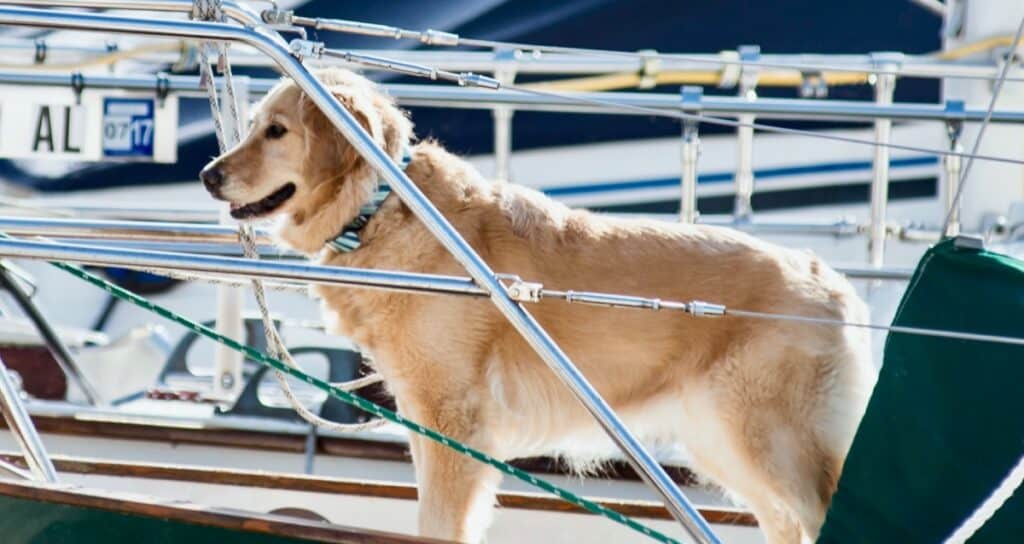
Pamela says
LOVE Pluto’s video. He looks like quite the relaxed cruising gentleman. And great job on the companionway steps!
The Boat Galley says
Great job of walking up/down the steps!
Pamela says
The truth is caring for any dog is harder than not. But it’s oh so worth it.
Pamela says
I’ll start saving my pennies. Dyson seems to be the best.
Carolyn Shearlock says
Most countries are not going to allow a wolf or wolf mix in. A secondary issue is whether the animal could begin to get enough exercise on a boat. Considering that our tiny 7-pound dog starts going stir crazy for not getting enough exercise after about 3 days, I think it would be EXTREMELY difficult to have a wolf mix on board for any length of passage.
Carolyn Shearlock says
That will be a BIG change. But he’s young and adaptable!